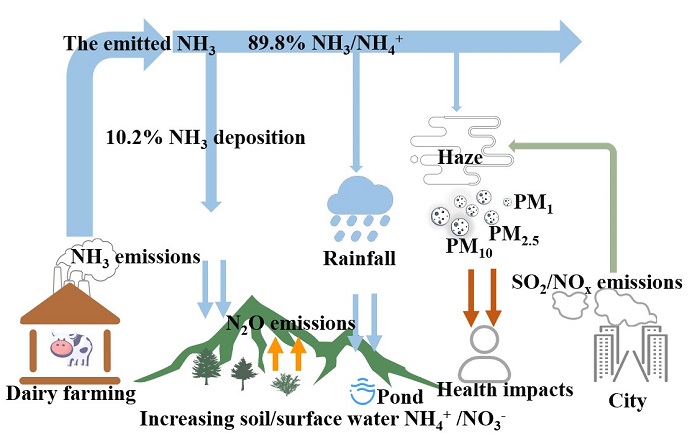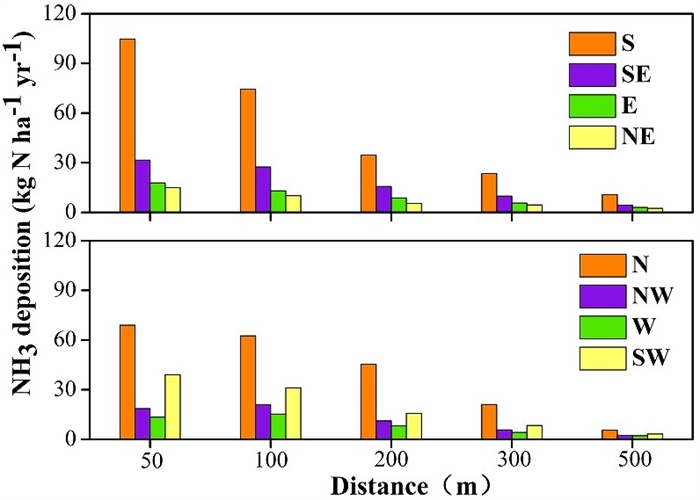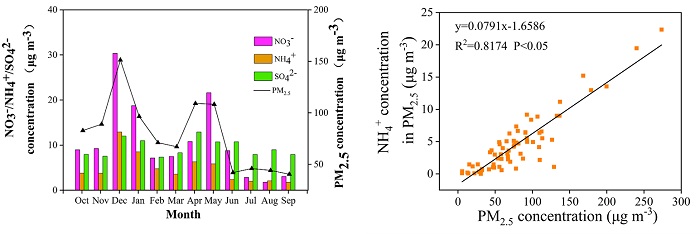Intensive Animal farms Amplify Atmospheric Nitrogen Deposition and Aerosol Pollution
A recent study led by Prof. Jianlin Shen from the Institute of Subtropical Agriculture, Chinese Academy of Sciences, has revealed the significant environmental impacts of ammonia emissions from intensive dairy farms on atmospheric nitrogen deposition and aerosol pollution. The findings, published in the prestigious journal Agriculture, Ecosystems & Environment (2025), provide critical insights into mitigating air pollution and ecosystem eutrophication caused by intensive animal farming.
Ammonia (NH3), the most abundant alkaline gas in the atmosphere, reacts with acidic gases to form secondary aerosols, contributing to air pollution. Atmospheric ammonia-derived nitrogen dry and wet deposition also constitutes a major source of atmospheric total nitrogen deposition, leading to eutrophication in natural ecosystems. Intensive animal farms are key sources of ammonia emissions, yet how the emitted ammonia deposits around the source and affects atmospheric total nitrogen deposition, as well as influences PM2.5 composition and concentration, remains unclear.
To address these questions, Prof. Shen’ research team conducted a one-year investigation at a typical intensive dairy farm in Central China (housing 800–1,000 cow monthly). Using a novel near-source atmospheric ammonia deposition monitoring method, they quantified ammonia deposition, total nitrogen deposition, and PM2.5 concentration in the vicinity of the dairy farm. Key findings include:
- Annual ammonia emissions averaged 26.3 kg N yr⁻¹ head⁻¹, with near-source (within 500 m) deposition accounting for 10.2% of total emissions (20 kg N ha⁻¹ yr⁻¹).
- Near-source ammonia deposition exhibited spatiotemporal variability driven by farm emissions, wind direction, frequency, and speed.
- Total atmospheric nitrogen deposition within 500 m of the farm reached 78.4 kg N ha⁻¹ yr⁻¹, 2.1 times higher than those in the arears far from intensive animal farms.
- PM2.5 concentrations near the farm averaged 79 μg m-3, 1.8 times higher than those at adjacent urban sites. Ammonium-related aerosols (NH4+, NO3-, SO42-) comprised 23.1%–52.0% of PM2.5 mass, with PM2.5 levels strongly correlated with particulate NH4+ concentrations.
“Our results highlight intensive dairy farms as hotspots for atmospheric nitrogen deposition and aerosol pollution,” said Prof. Shen, the corresponding author of this study. “Reducing ammonia emission from intensive animal farms are urgently needed to alleviate environmental pressures.”
Contact: Jianlin Shen
E-mail: jlshen@isa.ac.cn

Figure 1 Schematic diagram of ammonia emissions, near-source deposition, and ecological impacts from intensive dairy farms (Imaged by Jianlin Shen)

Figure 2 Ammonia deposition at varying distances from the farm under eight predominant wind directions (Imaged by Jianlin Shen)

Figure 3 PM2.5 concentrations, ammonium-related aerosol components, and their correlations (Imaged by Jianlin Shen)
Download attachments: